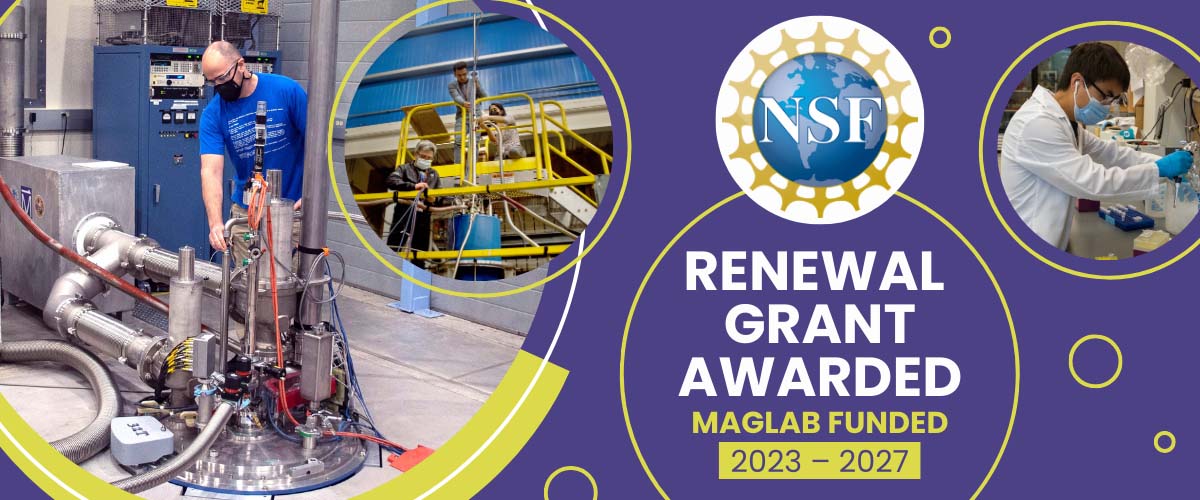Contact: Kristin Roberts
TALLAHASSEE, Fla. — The National High Magnetic Field Laboratory will receive $195.5 million over the next five years, a move that keeps the world’s most powerful magnet lab headquartered at Florida State University with partner sites at University of Florida and Los Alamos National Laboratory and supports groundbreaking discoveries using high field magnets.
The National Science Foundation funding, authorized by the National Science Board, is a 6% increase in the lab’s funding levels.
"The U.S. National Science Foundation is proud to support this unique and world-leading research facility through a vibrant partnership with our three collaborating institutions and the State of Florida," said NSF Director Sethuraman Panchanathan. "NSF's continued support for the National High Magnetic Field Laboratory drives the democratization of access to high magnetic fields; enables worldwide discoveries at the forefront of science, engineering and technology; and helps develop a highly skilled and diverse workforce."
This funding maintains the National MagLab as a worldwide research destination with continued support for a high magnetic field user program that has hosted more than 30,500 physicists, chemists, biologists and engineers from 54 countries and 50 states and territories who have conducted experiments since the lab was established in the early 1990s.
“The MagLab research portfolio touches so many of today’s major scientific challenges,” said MagLab Director Greg Boebinger. “High magnetic fields are revealing new materials for quantum technologies, combatting climate change, protecting human health, enabling the magnet-based machines of the future, and paving the way to new energy solutions.”
Researchers come to the MagLab to use a fleet of world-record magnets, including a 32-tesla all-superconducting magnet, the world’s most powerful superconducting magnet and a 2022 R&D 100 award winner. These powerful magnets coupled with the expertise and unique instruments only available at the National MagLab have facilitated many recent discoveries across physics, materials science, chemistry, biology and engineering.
"The MagLab, its faculty, and staff are a national treasure," said Florida State University Vice President for Research Stacey Patterson. "While the lab serves a fundamental purpose of furthering knowledge, it also plays an important role in working with industry to enhance available technologies in areas such as magnet manufacturing, MRIs, and more."
Some of the most recent discoveries at the lab include:
- A unique phenomenon known as “Lazarus superconductivity” was observed under the influence of both continuous and pulsed high magnetic fields where superconductivity arises, perishes, then return to life in a unique uranium-based compound.
- Researchers learned that exposure to sun and water causes thousands of chemicals to leach from road pavement into the environment with the power of a 21 tesla Ion Cyclotron Resonance magnet system.
- Using the 36 tesla Series Connected Hybrid magnet, scientists found that interactions between strings of bonded water molecules and a small protein were much stronger and longer-lasting — more than a million times longer— than researchers had previously believed, further showing the role “water wires” play in cell function.
- A mini magnet less than four inches in size made of rare earth barium copper oxide (REBCO) superconductors and no insulation broke a record for magnetic field strength, reaching half a tesla more than the lab’s 45T hybrid magnet.
"High magnetic fields unleash unique probing capabilities that enable scientists to address fundamental questions in a wide swath of disciplines, including materials science, physics, chemistry, biology, engineering and medicine," said Leonard Spinu, NSF's program director for NSF’s MagLab. "The National High Magnetic Field Laboratory continues to lead by forging paths for advances with significant societal impacts, from the next generation of microelectronics and quantum devices, to clean energy technologies, to advances in medical diagnoses and treatments."
Beyond continued support for the MagLab’s user program, the grant funds a new effort to broaden the impact of experiments conducted in the lab’s world-unique instruments and expand the lab’s user community. A new MagLab Center for FAIR and Open Science will ensure that data taken on the MagLab’s world-unique instruments are shared openly to benefit the entire scientific community, facilitating a new type of MagLab user: a “Data User” who accesses high-quality MagLab data to advance their own independent research goals. MagLab data has already been used to model the impact of evolution on an RNA-binding protein in mammals dating back 160 million years and to help design new algorithms and software tools to understand protein fragmentation.
In addition to this large investment from the NSF, the MagLab is a unique federal-state partnership that receives critical financial support from the State of Florida each year. For this support, the MagLab contributes significantly to the state’s economy, generating $6.44 of economic activity for every state dollar invested in the facility. Based on a report by the Center for Economic Forecasting, the MagLab is projected to generate about $6.5 billion in economic activity and more than 53,600 jobs in Florida over the next 20 years. As a taxpayer-funded facility, the MagLab invites its public stakeholders to learn more about the lab and its amazing discoveries through monthly public tours or the annual Open House event. The next Open House will be on Saturday, February 25, 2023.
This award concludes a multiyear renewal proposal process that engaged the lab’s user community, its three host institutions, industry partners, and other collaborators from around the globe. The renewal proposal was peer reviewed by worldwide scientific and engineering experts and approved by the National Science Board, the governing board that approves major awards from the NSF.



